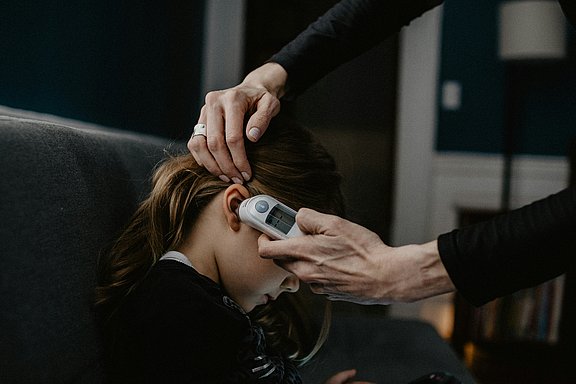Fit for fever
Project overview
The FitFürFieber innovation fund project is trialling digital and multimedia care for children with fever in order to promote the appropriate and safe handling of this physiological reaction. Doctors are taking part in an online training course on the current fever guideline. At the same time, parents in around 170 paediatric practices in North Rhine-Westphalia and Bavaria will receive a comprehensive information package via the "Meine pädiatrische Praxis" practice app from the Professional Association of Paediatricians, the fever app(FeverApp) and other digital offers.
An additional, personal information session following a regular check-up is intended to further strengthen and support parents. An accompanying comparative study will examine how this new form of care affects prescription behaviour, emergency presentations and the overall health care economics situation. A survey on attitudes towards fever and a detailed analysis of effectiveness complete the research design.

Further information
- Responsible: Chair of Medical Theory, Integrative and Anthroposophic Medicine
- Funding: Innovation Fund of the Joint Federal Committee
- Duration: three years
- Consortium partners: BVKJ-Service GmbH (100% subsidiary of the Berufsverband der Kinder-und Jugendärzt:innen e. V.) and the Institute for Health Care Research and Health Care Economics at Heinrich Heine University Düsseldorf
- Cooperation partners:
Kassenärztliche Vereinigung Nordrhein
Kassenärztliche Vereinigung Westfalen-Lippe
Kassenärztliche Vereinigung Bayerns
Bundeszentrale für gesundheitliche Aufklärung (BZgA)
dsai e. V.
DAK-Gesundheit
Background
Protective and warning mechanism of the child's organism
In paediatrics and adolescent medicine, fever has always been regarded as an important first sign of illness. At the same time, the increase in body temperature associated with fever leads to an accelerated reaction of the immune system and thus contributes to the fight against pathogens. Nevertheless, fever causes anxiety in many parents and is often the reason for a disproportionately high number of emergency visits to paediatric practices and outpatient clinics. In addition, misdiagnoses occasionally lead to unnecessary hospitalisations or antibiotic prescriptions, which in particular increases the risk of antibiotic resistance and the associated burden on the body, the environment and the healthcare system.
The complexity of dealing with fever and its effects
The significance of fever for a child's health is complex, as subjective fears and ignorance also play a role alongside the physiological protective function. Parents react differently to the first signs of an increased body temperature. In addition, individual experiences, cultural influences and the respective level of information about fever influence both the way affected children are treated and the decision about medicinal interventions.
Project management

Prof. Dr. med.
David Martin
Chair holder
Faculty of Health (School of Medicine) | Chair of Medical Theory, Integrative and Anthroposophic Medicine
- +49 2330 62-4760
Orcid ID: 0000-0002-4279-3032
Gerhard-Kienle-Weg 4
58313 HerdeckeRoom number: Haus D, DG

Prof. Dr. med.
Ekkehart Jenetzky
Professor
Faculty of Health (School of Medicine) | Chair of Medical Theory, Integrative and Anthroposophic Medicine
- +49 2302 926-7730
Orcid ID: 0000-0001-5415-8784
Alfred-Herrhausen-Straße 50
58455 WittenRoom number: C-2.330